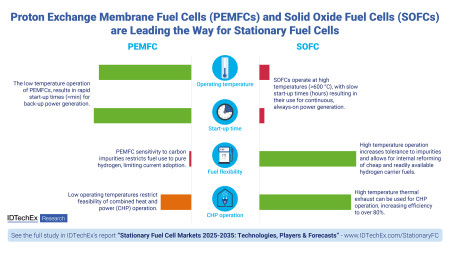IDTechEx Report Highlights Technologies Leading Stationary Fuel Cells to a US$8B Market

BOSTON, October 16, 2024 (Newswire.com) - Hydrogen fuel cells are a renewable energy technology that is receiving increasing commercial interest, with growing pressures for companies to improve their green credentials, alongside a global target to reach Net-Zero by 2050, driving this attraction. Traditional renewable technologies such as solar and wind have garnered significant attention, however, due to their intermittent nature, additional technologies which can provide on-demand and continuous power are required, leading to the growing attention into hydrogen fuel cells for stationary power generation.
In their new report “Stationary Fuel Cell Markets 2025-2035: Technologies, Players & Forecasts”, market intelligence firm IDTechEx comprehensively covers the stationary fuel cell market, including the key application areas, breakdown of fuel cell (FC) power generation modes and assessment of the main trends anticipated within each sector. This analysis is carried out alongside an in-depth evaluation of the varying fuel cell technologies and benchmarking of their key specifications.
Maia Benstead, Technology Analyst at IDTechEx and co-author of the report, advises that granular market analysis sees IDTechEx forecast the stationary fuel cell market to exceed US$8 billion by 2035.
Uninterruptable power supplies are critical for mission-critical sectors like data centers, hospitals, and telecommunications, where power outages can cause severe safety, economic, and operational impacts. The US Department of Energy estimates power outages cost the US economy $150 billion annually. With electricity demand expected to grow 3.4% annually through 2026, energy security concerns are rising. Grid operators must utilize both traditional and new power generation technologies to meet increasing demand and address emerging challenges.
Benstead highlights, “Of the various types of fuel cell technologies, proton exchange membrane fuel cells (PEMFCs) have received the greatest commercial attention due to growing interest in their integration within automotive applications.”
PEMFCs, however, can only operate using pure hydrogen, a fuel which is currently costly compared to traditional non-renewable fuels like natural gas and diesel. Limited access to green hydrogen, and a lack of supply infrastructure, currently hinders the growth of the PEMFC stationary power market. However, it is likely that the development of the hydrogen economy will coincide with the growth of the PEM stationary fuel cell market.
Benstead explains that to address the current limitations in the stationary fuel cell market—primarily the cost and availability of hydrogen fuel—fuel cells that can run on various fuel types should be considered, with particular attention on solid oxide fuel cells (SOFCs), a high-temperature alternative to PEMFCs. IDTechEx finds that SOFCs present a unique opportunity for the stationary fuel cell market, helping to establish a secure installation base whilst the hydrogen economy develops, with the technology largely dominating the market growth.
Due to the varying operating conditions of PEMFCs and SOFCs, each is suited to a particular power generation mode. For more information on the different types of fuel cell technologies, their application areas and emerging trends within the market, see the IDTechEx report “Stationary Fuel Cell Markets 2025-2035: Technologies, Players & Forecasts” – www.IDTechEx.com/StationaryFC.
Source: IDTechEx
